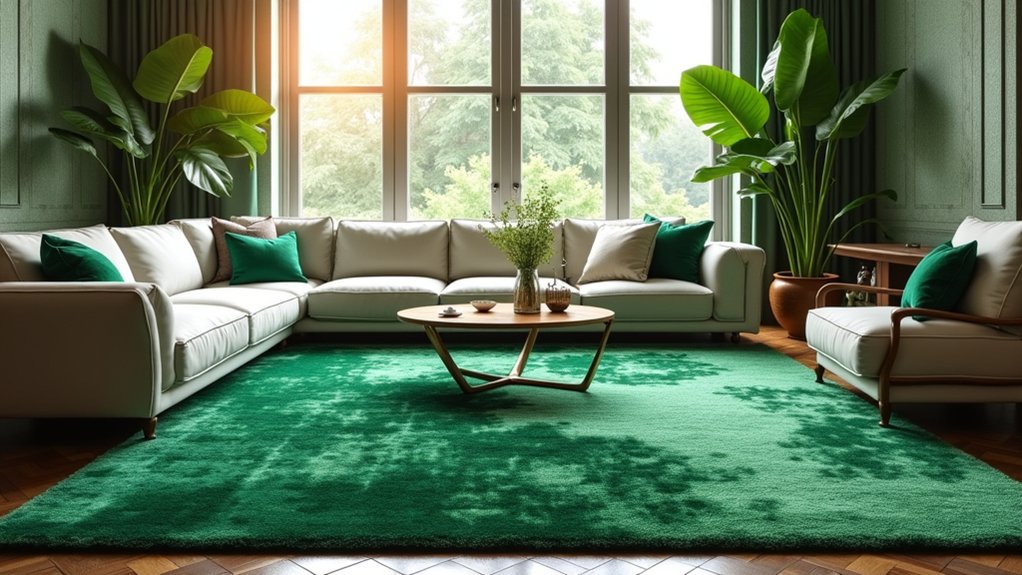
16 Green Living Room Rug Ideas That Ground Your Space Beautifully
Green living room rugs instantly anchor interiors with rich color and organic texture, from understated sage and earthy olive to bold emerald and dramatic ombre designs. Layering plush or flatweave green rugs over neutral foundations brings depth, while geometric patterns or oversized pieces make a statement in spacious rooms. Coordinating with wood accents, metallic details, or tonal green accessories adds contemporary allure and cohesion. Explore distinctive ideas that blend timeless elegance with modern trends for beautifully grounded spaces.
Key Takeaways
- Layer sage green rugs over neutral foundations to create a calming, sophisticated atmosphere that complements wood and organic modern décor.
- Use deep emerald green rugs with brass or gold accents for a luxurious statement and visual anchor in spacious living rooms.
- Combine plush and flatweave green rugs to introduce textural depth, warmth, and durability in high-traffic or seating areas.
- Choose patterned or bold geometric green rugs to add visual interest, dimension, and a contemporary touch to modern living rooms.
- Employ green rugs for zoning in open-plan spaces, using varying shades and textures to define areas while maintaining visual flow and cohesion.
Embracing Sage Green Rugs for a Calming Oasis
A sage green rug introduces an understated tranquility to the living room, setting the tone for a space that feels both serene and sophisticated. This hue, with its earthy undertones, effortlessly cultivates a calming environment, making it a favored choice for those seeking a tranquil atmosphere. Sage green rugs harmonize with neutral palettes—think whites and creams—bringing a gentle sophistication while visually expanding the room, especially in compact or minimalist interiors. Their subtle color complements organic modern aesthetics, blending seamlessly with wooden furniture and natural textures. Patterns and varied textures in sage green rugs can lend visual interest without overwhelming the senses, ensuring the space remains peaceful. These rugs embody a refined approach, grounding living spaces with a fresh, nature-inspired elegance that remains enduringly on-trend. Adding warm lighting enhancements can further elevate the cozy ambiance created by the sage green rug, enriching the space’s serene atmosphere.
Making a Statement With Deep Emerald Rugs
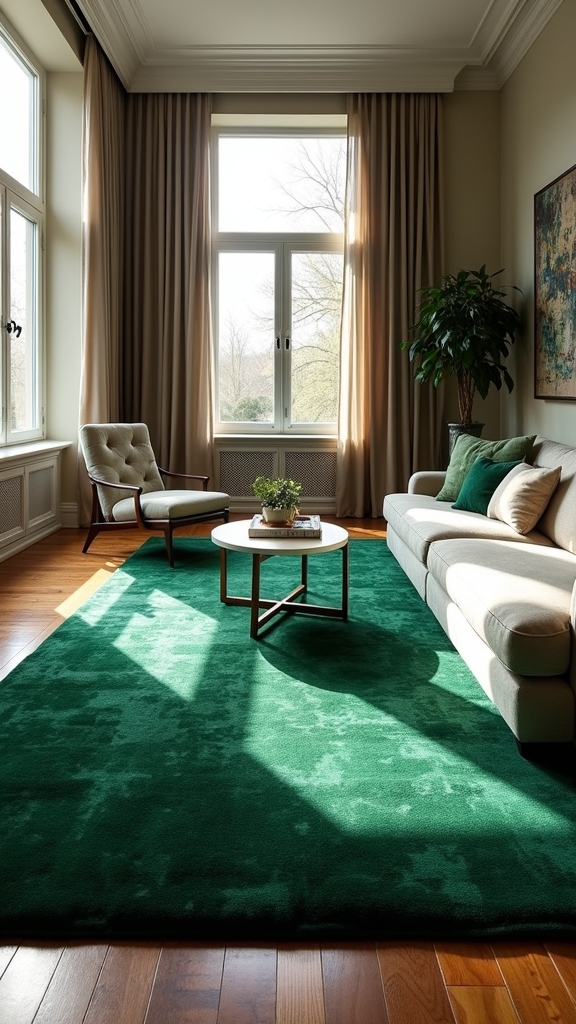
While many opt for subtlety in their living spaces, deep emerald rugs offer a bold alternative that instantly commands attention.
These rugs convey luxury and sophistication, their rich jewel tone serving as a bold statement piece that enhances the room’s atmosphere. Deep emerald pairs exquisitely with brass or gold accents, enriching the sense of opulence and creating a visually dynamic contrast against lighter furniture or decor.
The striking hue grounds the space, drawing the eye while highlighting surrounding elements. Remarkably, the versatility of deep emerald accommodates a variety of styles—from classic elegance to contemporary minimalism—seamlessly integrating into diverse interiors.
In larger living rooms, a deep emerald rug fosters intimacy and warmth, making the area feel both inviting and cohesive without sacrificing refined aesthetics.
Layering Green Rugs Over Neutral Foundations
Layering green rugs atop neutral foundations introduces nuanced depth through the interplay of contrasting textures, such as plush pile against flatweave.
A careful balance of patterned or solid green rugs with understated bases guarantees both visual harmony and a striking focal point.
Thoughtful colour pairing—like sage with ivory or emerald over taupe—enhances this look, aligning with contemporary living room trends.
Mixing Textures for Depth
By thoughtfully layering green rugs over neutral foundations, interior designers achieve a sophisticated interplay of texture and color that enhances the living room’s visual depth.
Mixing textures—such as placing a plush green shag rug atop a smooth jute or sisal base—creates visual interest while inviting a tactile experience that feels both grounded and luxurious.
This approach allows for subtle layering where complementary colors in both rugs harmonize, ensuring the space remains cohesive rather than chaotic.
The combination of different rug materials and thicknesses also delineates living zones, adding function and refinement.
Choosing green rugs with distinctive textures or gentle patterns boosts the room’s style, demonstrating an awareness of current trends that favor organic, layered environments rich in sensory appeal and visual complexity.
Balancing Patterns and Solids
A well-executed balance between patterns and solids enhances the impact of green rugs layered over neutral foundations, transforming the living room into a curated, visually cohesive retreat.
Pairing patterned green rugs with solid neutral rugs grounds the space, allowing the vibrant hues and motifs to draw the eye without overwhelming.
Layered rugs, especially when a plush green rug sits atop a flatweave neutral base, introduce depth and dimension that uplifts the entire aesthetic.
Selecting larger solid neutral rugs as the underlayer accommodates furniture placement, ensuring the green rug’s design remains a focal point.
Opting for complementary shades within the patterned green rug ties together disparate room elements, while the understated base provides a harmonious backdrop, resulting in visual interest that feels balanced and refined.
Colour Harmony Techniques
When green rugs are thoughtfully layered over neutral foundations, such as beige or cream, the result is a sophisticated interplay of color and texture that feels both curated and contemporary.
The use of a neutral foundation allows green shades—ranging from deep emeralds to soft sages—to take center stage, infusing the living room with visual interest without overwhelming the space.
Layering green rugs atop a larger neutral base creates a subtle frame, enhancing both depth and dimension.
Textures play an essential role; pairing a plush green rug with a flat-weave neutral rug adds tactile variety and richness.
To achieve a harmonious aesthetic, patterns in the green rug that echo the neutral’s undertones can seamlessly tie the composition together.
- Emphasize texture contrast for depth
- Select green shades that complement neutrals
- Reference neutral tones in green rug patterns
Choosing Olive Tones for Earthy Warmth
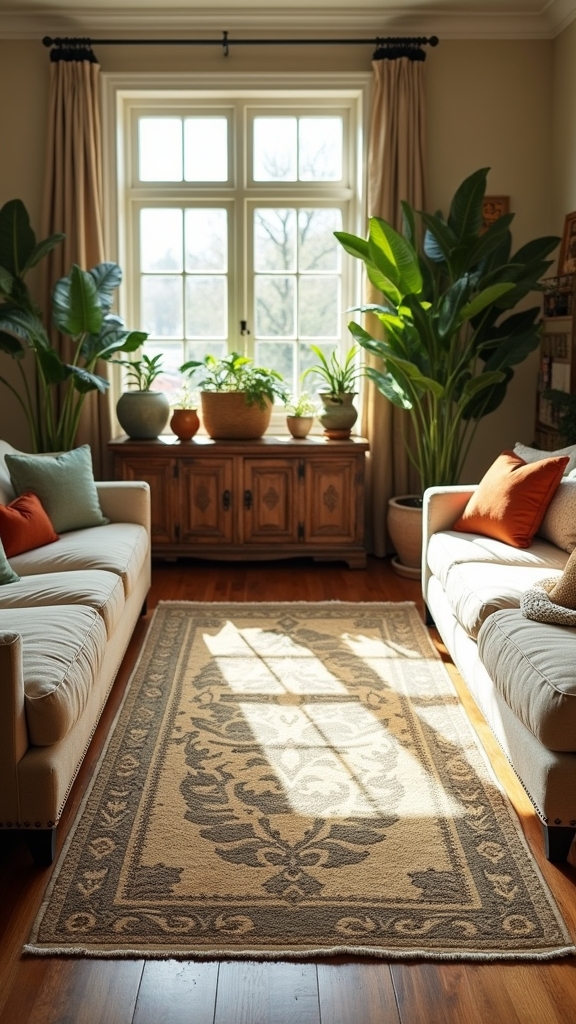
Although trends in interior design constantly evolve, olive green rugs have remained a timeless choice for those seeking to infuse living spaces with earthy warmth. The organic undertones of olive green evoke a sense of stability and natural beauty, grounding any room with an inviting, cozy aesthetic. This versatile hue seamlessly integrates with neutral palettes, accentuating the subtle elegance of beige, cream, or taupe walls and furnishings. Olive tones also complement wooden furniture and organic textures, further enhancing the relaxed environment so many desire in a living area. For those who wish to introduce a touch of color, olive green pairs beautifully with warm accents like orange or yellow, fostering a harmonious atmosphere that feels both fresh and enduring, adaptable to rustic and modern interiors alike. When considering brown living room decor, incorporating natural materials and houseplants can enhance the organic appeal, adding depth and visual interest to the space.
Pairing Forest Green Rugs With Classic Décor
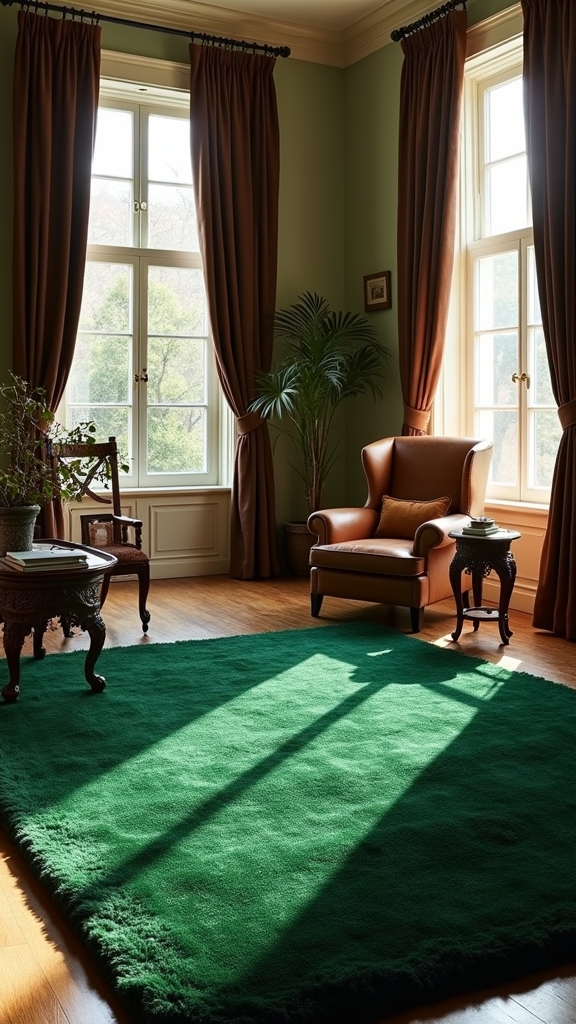
Forest green rugs introduce a sense of refined luxury that seamlessly complements classic décor, enhancing the enduring allure of traditional interiors.
Their rich hue pairs beautifully with ornate wood furnishings and timeless patterns, striking a balance between sophistication and comfort.
When thoughtfully integrated, these rugs anchor the space while contributing to an atmosphere of elegant harmony.
Enhancing Timeless Interior Elegance
Sophistication finds its anchor in the living room through the addition of a forest green rug, a choice that instantly enhances classic décor with its rich, regal undertones. This deep hue, synonymous with luxury, beautifully complements timeless designs by grounding the space with a sense of permanence and style.
When layered with textured elements—such as velvet throws or woven accents—the rug’s presence is deepened, lending an inviting tactility to the room. Neutral wall colors, like soft whites and gentle greys, serve as a refined backdrop, allowing the forest green to stand out without overwhelming.
Small touches of metallics, be it brass or gold, reflect light and underscore the space’s heightened aesthetic.
- Forest green rugs evoke enduring elegance and luxury
- Textured elements add depth and prevent flatness
- Metallic accents introduce subtle, sophisticated shine
Balancing Green With Tradition
When anchored in traditionally styled living rooms, a forest green rug becomes a bridge between classic and contemporary sensibilities, enhancing the room’s sense of refinement.
The deep, luxurious tones of forest green naturally complement classic décor, pairing harmoniously with ornate wooden furniture and rich textiles such as velvet drapes or brocade cushions. Brass or gold accents amplify the opulence of traditional spaces, while the grounding quality of the rug offers stability and understated elegance.
Forest green rugs, when set against soft warm whites or deep navy walls, achieve a timeless palette that feels cohesive and inviting.
Layering additional textures—like leather sofas or woven throws—enriches the environment, adding visual depth. This balance allows elegance to flourish without overwhelming the classic roots of the décor.
Highlighting Patterns for Visual Interest
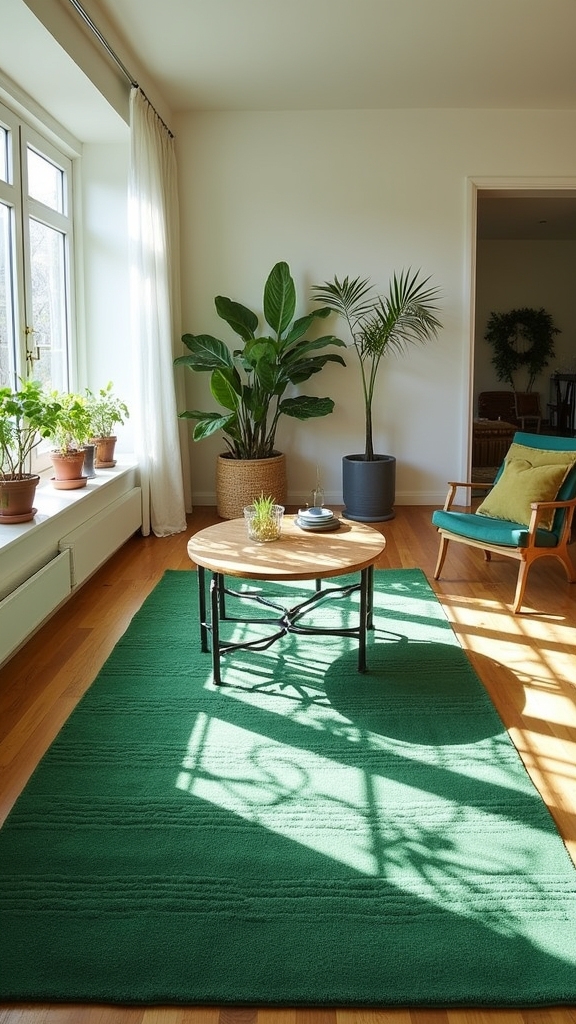
A multitude of patterned green rugs can transform a living room, introducing layers of visual intrigue that range from subtle woven textures to bold, statement-making motifs. Whether favoring geometric patterns for a contemporary edge or floral patterns for organic charm, carefully chosen rugs become a dynamic focal point. For spacious areas, large-scale designs deliver drama, while compact rooms benefit from understated patterns that quietly ground the space. Layering a patterned green rug atop a larger neutral foundation adds dimension, while accessorizing with coordinating cushions or artwork guarantees a harmonious aesthetic. Each element works cohesively to enhance visual interest and unify the overall design. Patterned rugs serve as artistic anchors, dictating the mood and color palette. Layering introduces depth and a custom-curated feel. Accessorizing echoes motifs for seamless visual cohesion. Additionally, incorporating oversized geometric art can modernize the space, creating bold statements and adding depth to the living room.
Creating Contrast With Bold Geometric Designs
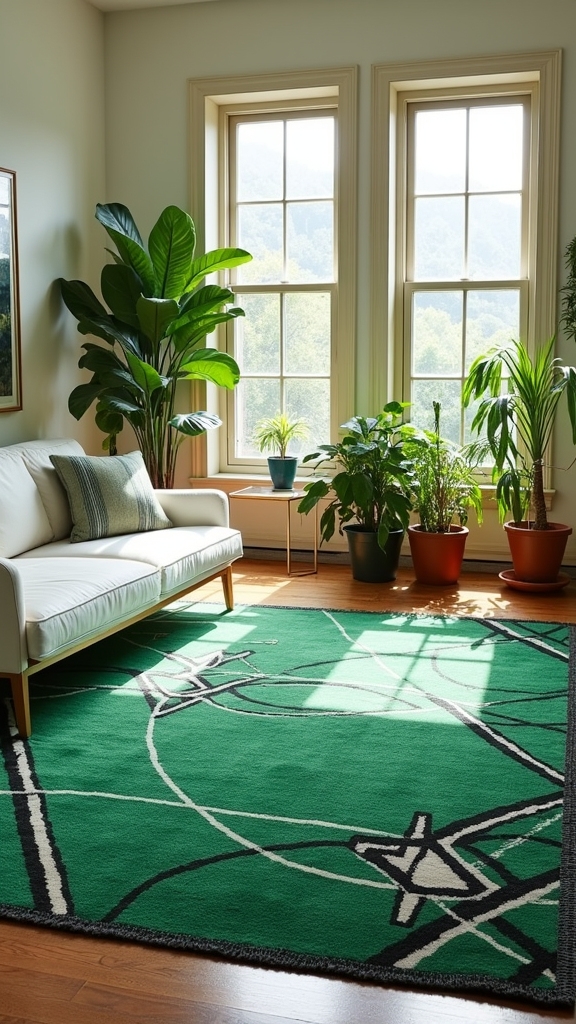
Bold geometric green rugs energize living rooms with vibrant patterns that instantly capture attention.
The interplay of crisp lines and contrasting hues balances both color and shape, offering a visually dynamic foundation.
This approach anchors modern decor, infusing the space with a sense of cohesion and contemporary sophistication.
Energising With Vibrant Patterns
Infusing a living space with energy and visual intrigue, vibrant green rugs featuring bold geometric designs serve as dynamic focal points within the room.
These rugs inject a lively pulse, their geometric patterns instantly drawing attention and contributing to a sense of movement and creativity.
Layering patterned rugs over larger, neutral-toned bases introduces depth and complexity, preventing monotony and ensuring visual interest without overwhelming the palette.
Selecting various shades of green within the pattern creates a contemporary touch that feels both fresh and intentional.
To maintain a cohesive look, echoing geometric themes through accessories—such as cushions or artwork—elevates the sense of harmony and purpose, tying the space together.
- Mix vibrant green rugs with neutral foundations for layered depth
- Select geometric patterns that complement existing décor
- Repeat geometric motifs in accessories for a cohesive look
Balancing Colour and Shape
Contrast emerges as a key design element when green rugs adorned with striking geometric patterns are introduced to a living room. A bold geometric motif, particularly in a rich emerald green, instantly enhances visual interest, transforming the rug into an enchanting focal point.
When juxtaposed with neutral-toned furnishings, these geometric patterns infuse modernity and dynamic energy, ensuring the space feels both lively and thoughtfully curated. The interplay of varying green tones within the geometric designs adds depth and tactile intrigue, while maintaining a cohesive color palette that harmonizes the overall aesthetic.
Such choices balance softer furniture lines, preventing monotony and creating a well-rounded environment. For those seeking a contemporary edge, geometric green rugs offer an on-trend solution that grounds and enlivens the room.
Anchoring Modern Decor
When geometric green rugs are introduced to modern living rooms, their sharp lines and dynamic shapes immediately inject a sense of structure and intrigue.
These green rugs serve as a sophisticated focal point, especially in minimalist spaces where every design choice is intentional. Bold geometric patterns offer striking contrast against sleek, neutral-toned furniture, amplifying both visual depth and textural richness.
Opting for larger geometric motifs enhances anchoring, grounding the open layout and balancing airy volumes. Layering a geometric green rug atop a larger neutral rug is a trend-forward strategy, creating dimension while maintaining cohesion throughout the modern décor.
This approach seamlessly combines functionality and artistry, ensuring the living room feels both inviting and contemporary.
- Green rugs with geometric patterns define spatial zones
- Contrasting colors highlight modern décor’s clean lines
- Anchoring rugs unify minimalist spaces with artistic flair
Mixing Textures With Plush and Flatweave Green Rugs
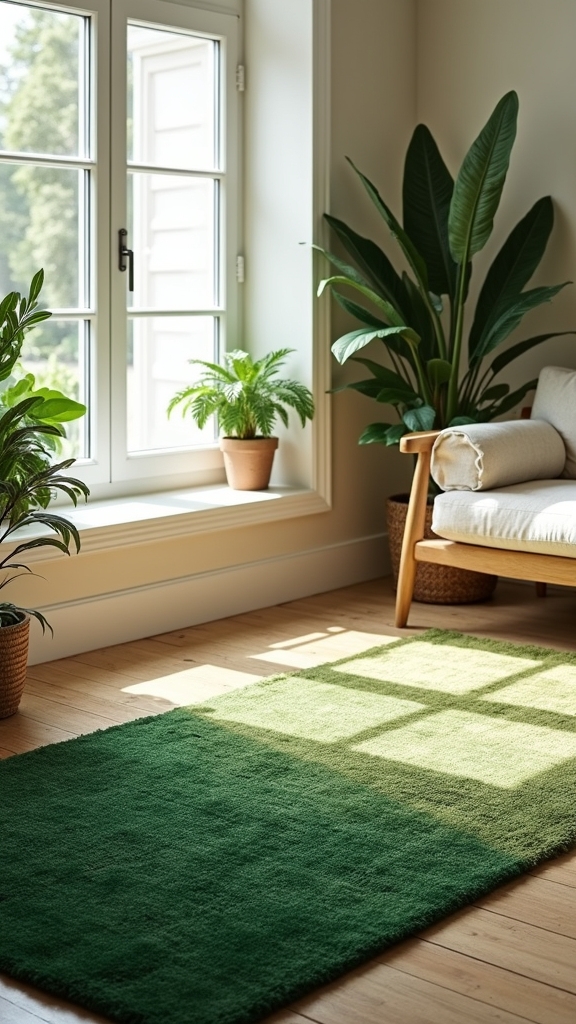
Texture plays a pivotal role in modern living room design, and the interplay of plush and flatweave green rugs introduces both visual intrigue and tactile depth to the space.
By layering plush green rugs—such as shag or tufted varieties—over flatweave green rugs, designers achieve a dynamic contrast of textures that instantly enhances the room’s aesthetic. Plush green rugs lend warmth and a cozy atmosphere to seating zones, inviting relaxation underfoot.
In contrast, flatweave green rugs offer durability and a minimalist, contemporary edge, making them ideal for high-traffic areas. This thoughtful combination prevents the space from feeling flat, infusing it with visual interest and a sense of intentional design.
Layering these green rugs is an on-trend method for creating a richly inviting environment.
Combining Green Rugs With Natural Wood Accents
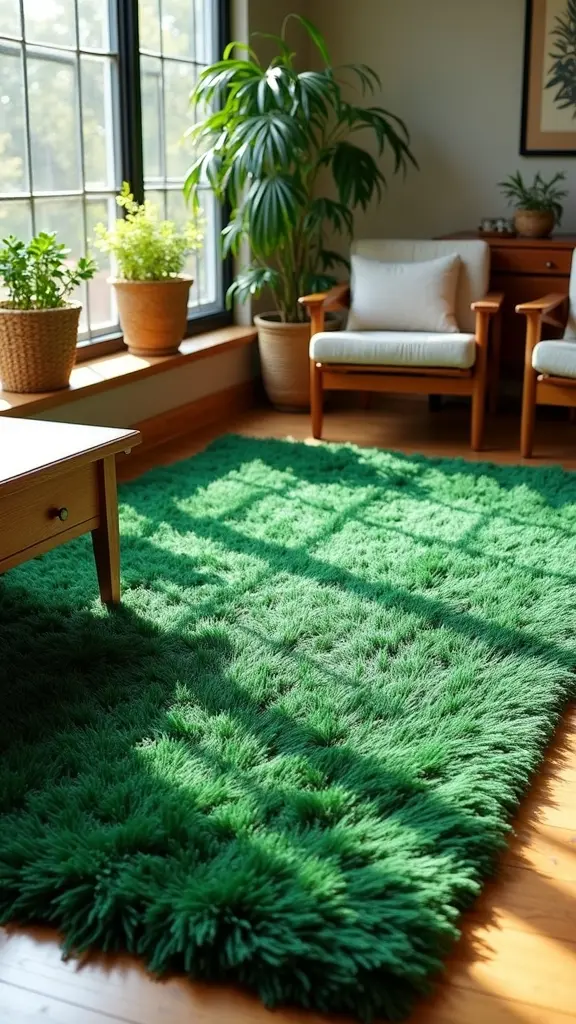
Although green rugs have long been favored for their versatility, their ability to enhance natural wood accents stands out as a particularly refined design choice. When green rugs—especially those in olive, forest, or sage—are layered over hardwood floors, the interplay of earthy tones creates a dynamic yet tranquil environment. The warmth of natural wood accents, whether light oak or deep mahogany, is subtly amplified by the grounding presence of green rugs. This thoughtful pairing not only brings a cozy atmosphere but also connects the interior to nature, reflecting a contemporary appreciation for organic design. Layering textured green rugs over wooden floors introduces both visual depth and tactile comfort. Matching the rug’s undertones to wood finishes creates seamless flow throughout the space. Earthy combinations foster tranquility and a grounded, inviting living area.
Using Green Rugs to Define Open-Plan Spaces
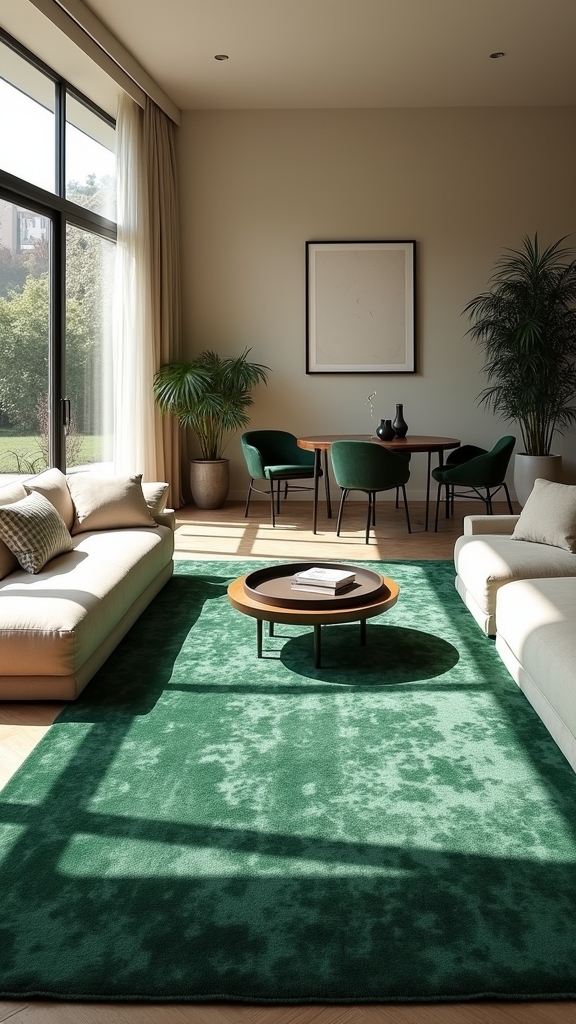
Green rugs offer a refined approach to zoning within open-plan living areas, subtly distinguishing lounge, dining, or reading nooks without sacrificing visual flow.
Thoughtful layering—such as placing a sage or emerald rug atop a larger neutral base—adds texture and gently marks boundaries.
When paired with streamlined furniture, this technique creates cohesion while allowing each defined space to feel balanced and intentional.
Zoning With Area Rugs
Among the most versatile tools in contemporary interior design, area rugs serve as subtle yet powerful elements for zoning open-plan spaces.
Green rugs, in particular, can define distinct zones—such as living, dining, or work areas—by establishing visual boundaries while maintaining a harmonious flow.
Larger rugs effortlessly anchor seating arrangements, while layered or patterned green styles introduce depth without sacrificing cohesion.
Varying shades of green—from soft sage for calm corners to bolder tones for vibrant areas—allow each zone to express its own mood yet contribute to an integrated look.
Attention to scale and placement guarantees each rug functions not only as a design statement but also as a spatial guide.
- Larger rugs anchor furniture groupings
- Contrasting shades of green define individual zones
- Layered rugs add visual interest and subtle boundaries
Visual Flow and Cohesion
How can open-plan living achieve both distinction and unity? Green rugs offer a sophisticated solution, guiding visual flow while anchoring each zone within a larger space.
A soft sage or mint green rug delineates areas—such as living and dining—without fragmenting the room, instead fostering a cohesive aesthetic. The calming atmosphere created by green tones encourages relaxation, softening the shifts between functional spaces.
Layering a green rug atop a neutral foundation subtly enhances depth and texture, ensuring the rug becomes a graceful focal point rather than an overpowering element. Pairing these rugs with neutral-toned furniture allows the green to sing, creating balance throughout the open plan.
Accents in various green shades—through cushions or artwork—harmonize the scheme, maintaining seamless visual flow.
Layering for Distinction
While open-plan living celebrates spaciousness and fluidity, intentional layering of rugs introduces structure without sacrificing style.
By thoughtfully layering green rugs, homeowners can create visual distinction between functional zones—subtly separating a lounge from a dining area. Choosing rugs that complement in both shade and texture, such as a soft sage atop a neutral foundation, achieves cohesion while letting the green hue flow seamlessly.
Contrasting textures and patterns enhance depth, drawing the eye and elevating the overall design. Strategically placed rectangular and runner green rugs not only guide movement but also anchor furniture, making open spaces feel curated and inviting.
- Layering green rugs defines areas, imparting both order and artistry.
- Complementary shades and textures unify the space’s aesthetic.
- Anchor furniture groupings with strategic rug placement for a balanced look.
Accentuating With Green and Blue Colour Palettes
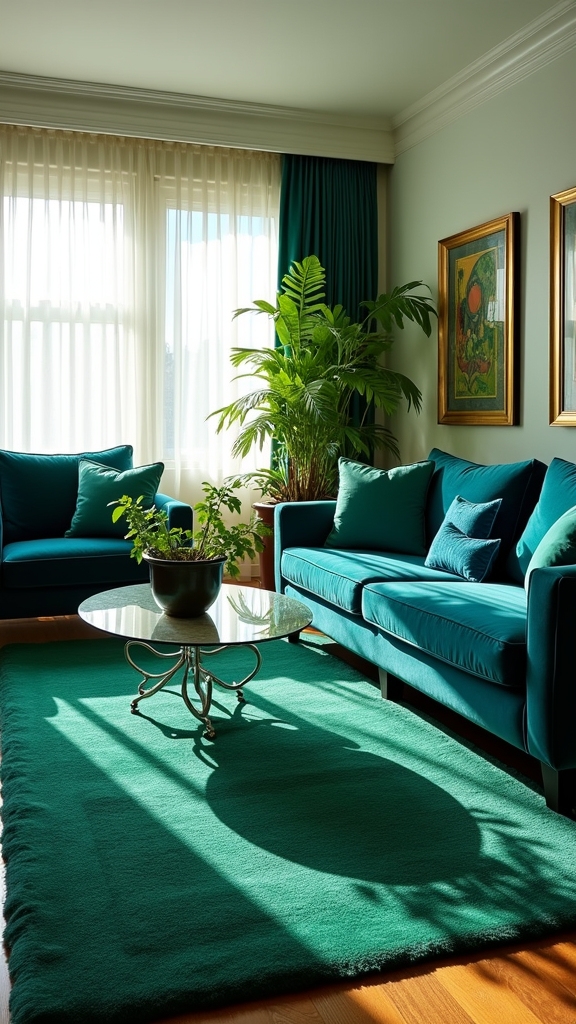
Countless modern interiors are embracing the harmonious pairing of green and blue colour palettes to enhance living room aesthetics. Green rugs, when paired with blue accents, deliver a calming atmosphere reminiscent of nature’s tranquility. Soft sage green rugs work elegantly with light blue hues, establishing a harmonious aesthetic ideal for relaxation. For greater depth, designers are turning to darker green rugs—think forest or emerald—contrasted with navy or teal blue furnishings, which lend sophistication and layered visual interest. Blue decorative elements, such as cushions or artwork, reinforce the cohesion of the space, tying the palette together seamlessly. The versatility of these colours enables interior design schemes ranging from muted pastels to vibrant jewel tones, encouraging personal expression while ensuring a timeless, serene foundation for any living room. Incorporating plants like the String of Hearts can further enhance the natural ambiance, adding unique texture and visual interest to the decor.
Coordinating Green Rugs With Metallic Accessories
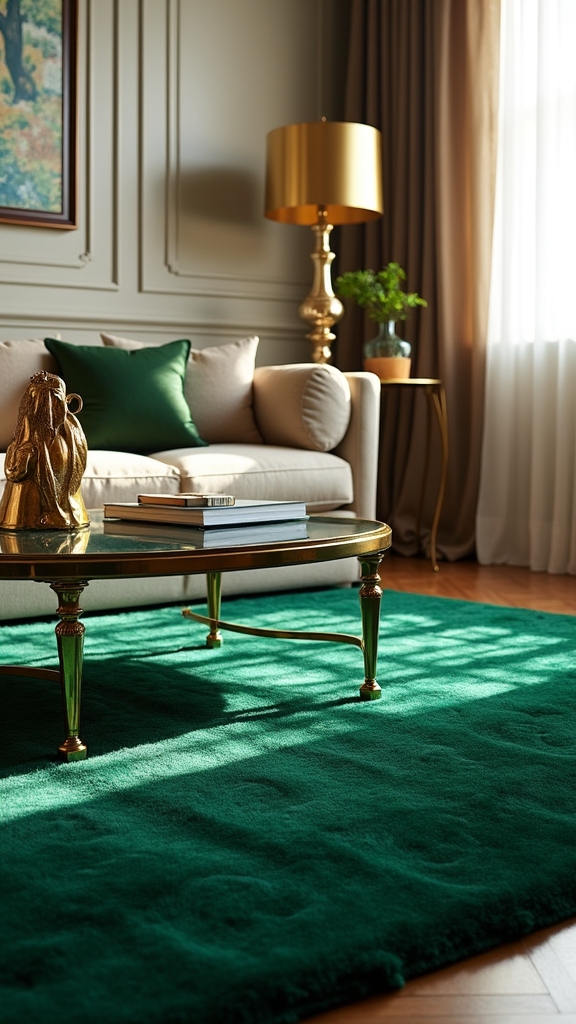
A subtle interplay between green rugs and metallic accessories is redefining modern living room design, introducing a dynamic blend of earthy warmth and refined glamour.
Deep emerald green rugs, when paired with brass or gold metallic accessories, project a sense of luxury and richness, while olive and sage green rugs offer a soothing foundation that harmonizes with sleek silver or chrome finishes.
The contrast between the organic tones of green and the sheen of metal creates visual intrigue, but achieving a cohesive design requires careful attention to undertones.
Metallic elements can be seamlessly incorporated through furniture legs, statement lighting, or curated decorative objects, elevating the space without overpowering it.
- Harnessing contrast: Gold with deep emerald for drama
- Promoting tranquility: Silver with olive and sage green
- Achieving cohesion: Harmonize undertones for seamless design
Styling Minimalist Spaces With Light Green Rugs
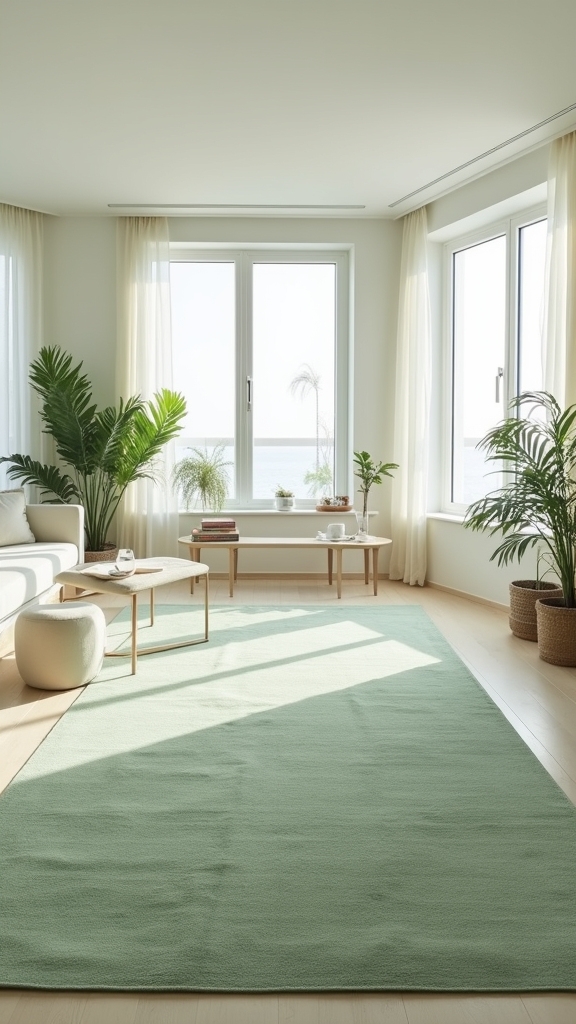
Evoking a sense of calm and subtle sophistication, light green rugs—such as soft sage or mint—have become an essential element in minimalist living rooms.
These light green rugs promote a calming atmosphere, visually expanding minimalist spaces and enhancing their inherent sense of openness. When paired with neutral-toned furniture like whites or beiges, the rug serves as a gentle focal point, anchoring the room without detracting from the clean simplicity that defines minimalist design.
Textured rugs in velvet or woven finishes introduce depth and tactile interest, offsetting the sleek lines of modern interiors. For added dimension, layering rugs—placing a light green rug atop a larger neutral base—creates a dynamic yet serene composition, maintaining a curated, tranquil aesthetic in any minimalist living area.
Enhancing Boho Vibes With Ombre Green Rugs
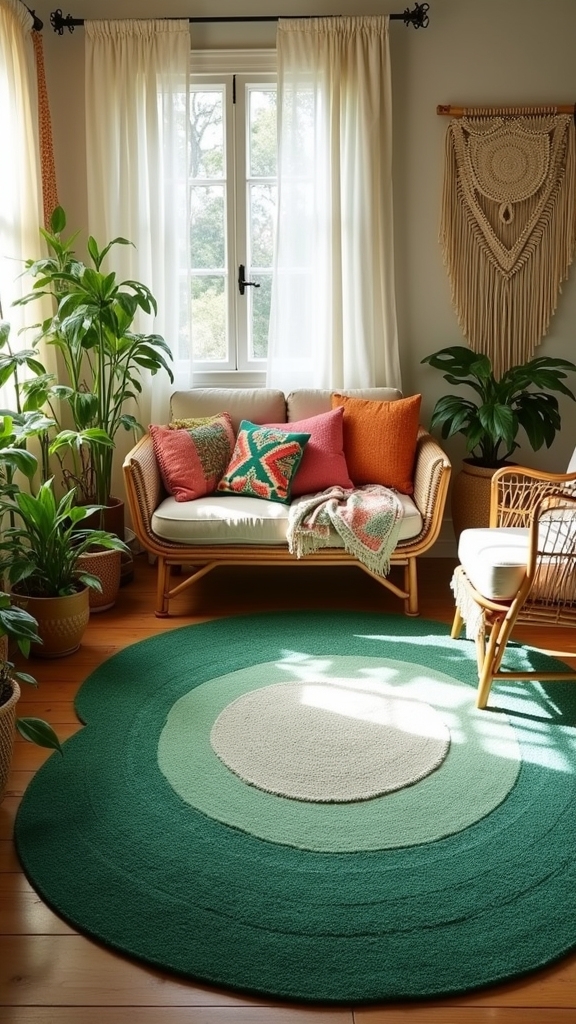
While light green rugs quietly amplify the tranquility of minimalist spaces, ombre green rugs introduce a richer visual narrative to boho-inspired living rooms.
These rugs, with their seamless gradient from light to deep green, evoke the shifting hues of nature, lending depth and dimension to any setting. The interplay of earthy tones in ombre green rugs harmonizes with the eclectic spirit of boho décor, grounding the space while encouraging playful layering of textiles and patterns.
Their versatility shines, offering a bridge between neutral furnishings and vibrant accessories, all while helping dwellers connect with organic elements. Incorporating natural elements and greenery, such as plants and eco-friendly materials, complements the earthy tones of ombre green rugs, enhancing the bohemian aesthetic.
As a focal point, an ombre green rug becomes more than decor—it anchors the room’s energy and celebrates a layered, earthy aesthetic.
Anchoring Large Living Rooms With Oversized Green Rugs
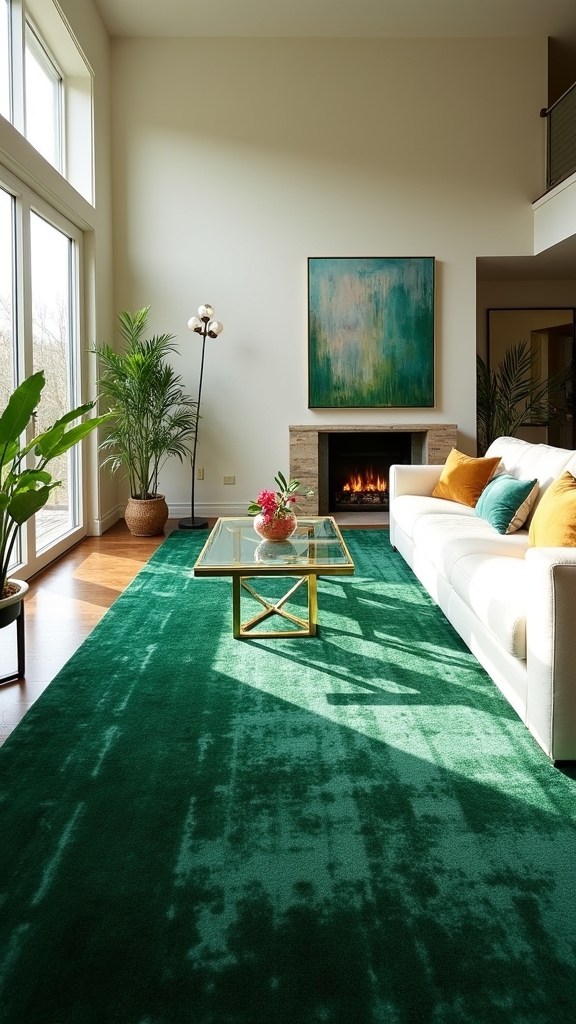
Scale becomes an essential design tool in expansive living rooms, where oversized green rugs—such as 8×10 or 9×12—define and ground the seating area with purpose. These substantial rugs anchor the space, providing a clear framework for arranging furniture while preventing the room from feeling fragmented. A deep emerald green option introduces luxury and sophistication, especially when paired with rich woods and brass for a cohesive effect. To enhance depth and visual interest, designers often layer oversized green rugs atop neutral bases or select textured or patterned varieties, adding dimension and character. Incorporating complementary colors—think warm neutrals or subtle contrasting tones—balances the boldness of green and creates a harmonious palette. This approach guarantees large living rooms feel intentional, inviting, and visually anchored. Additionally, using layered illumination techniques with ambient, accent, and task lighting can further enhance the atmosphere and functionality of the space.
Curating a Monochromatic Look With Varied Green Shades
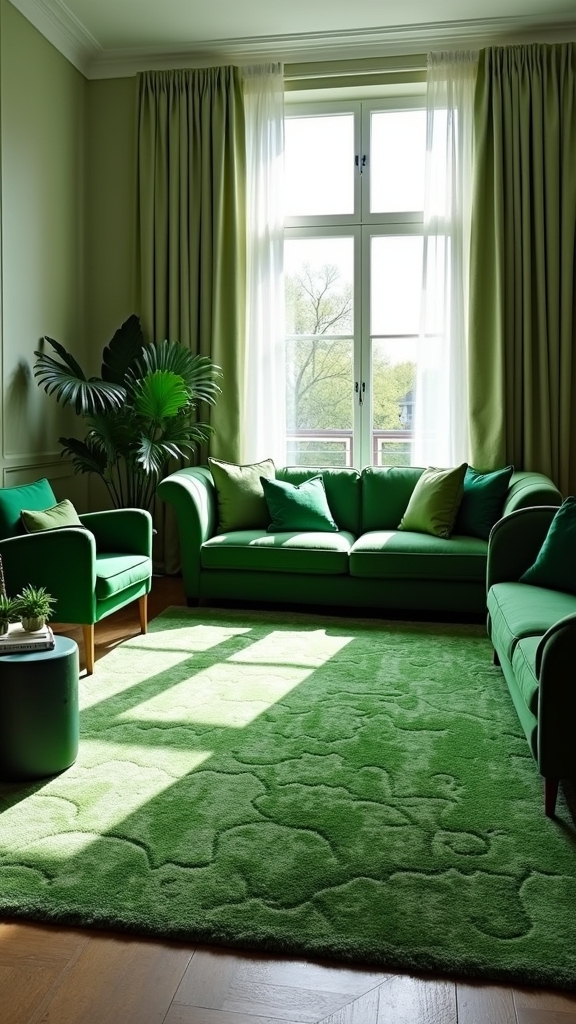
By thoughtfully layering varied shades of green, a living room can achieve a nuanced monochromatic aesthetic that exudes both harmony and depth. A soft sage rug sets a tranquil foundation, while deeper forest green accents—perhaps in velvet cushions or ceramic vases—bring visual intrigue.
Opting for textured green rugs, such as plush shag or flatweave designs, adds tactile richness without disrupting the color story. Accessorizing with pillows and artwork in mint or olive tones further refines the space, ensuring every element feels curated.
Subtle patterns, like stripes or botanicals within the green spectrum, create a lively yet unified ambiance. Neutral base furnishings, such as a cream sofa, allow these green shades to ground and define the room.
Incorporating houseplants like Monstera Deliciosa, with its iconic split leaves and tropical elegance, can enhance the green ambiance while improving air quality.
- Layer textured green rugs for depth
- Accessorize with varied green-toned décor
- Select neutral furniture to highlight green shades
Frequently Asked Questions
What Color Rug to Put in a Green Room?
When choosing a rug color for a green room, one should assess green rug patterns, explore complementary colors, consider rug texture options, factor in seasonal rug changes, account for room size considerations, and prioritize easy rug maintenance tips.
Should the Rug Be Darker or Lighter Than the Sofa?
When deciding if a rug should be darker or lighter than the sofa, one must consider rug texture, sofa style, color harmony, room lighting, pattern balance, and personal preference to achieve an aesthetically pleasing, balanced, and trend-aware space.
What Color Sofa Goes With a Green Rug?
Selecting a sofa color for green rug patterns involves exploring green sofa combinations with neutrals, warm leathers, or bold hues. Accent colors selection, complementary cushion ideas, texture pairing tips, and room size considerations enhance a trend-aware, visually balanced aesthetic.
What Color Is Best for Living Room Area Rug?
When selecting a living room area rug, neutral color options offer timeless appeal, while vibrant accent choices create focal points. Earthy tones benefit warmth, contrasting shades add drama, and incorporating texture, pattern, and seasonal color trends enhances overall aesthetic harmony.
Conclusion
Green living room rugs offer endless possibilities for grounding a space with elegance and personality. From the soothing allure of sage to the bold richness of emerald or olive’s earthy warmth, each shade brings a unique mood. Whether layered atop neutrals or styled in monochrome, these rugs act as both anchor and accent—infusing rooms with color, texture, and style. Embracing this trend creates a harmonious, inviting foundation for any contemporary living space.
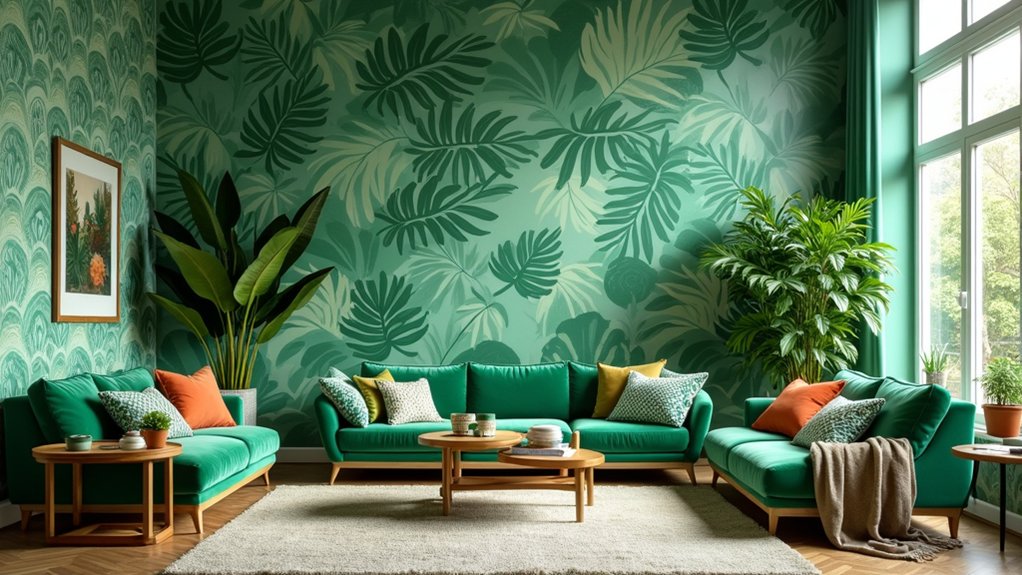
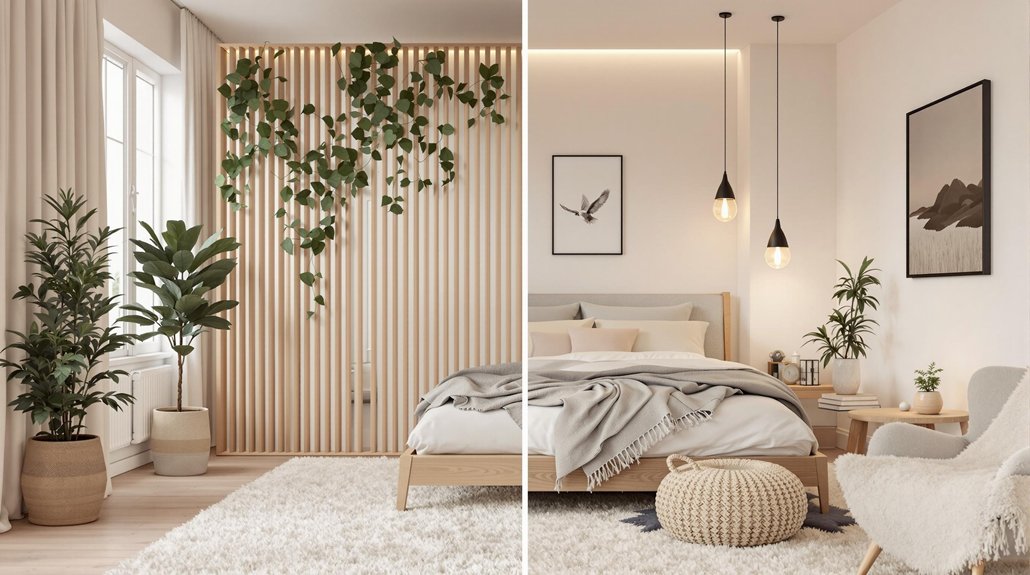
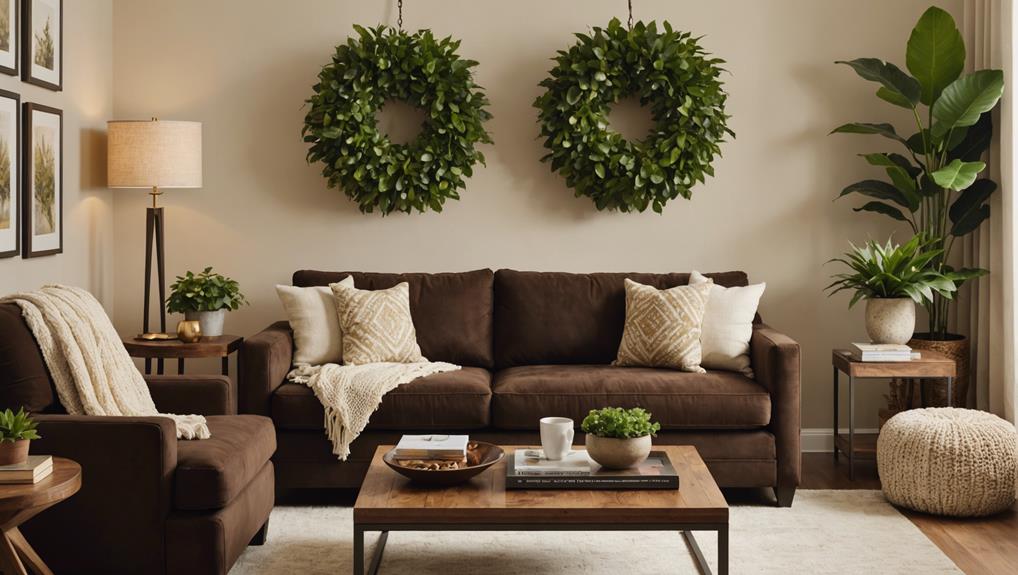
Leave a Reply